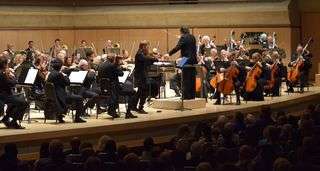|
Back
The TSO in fine form Toronto
Roy Thomson Hall
06/01/2016 - & June 2, 2016
Enrique Granados (orch. Otto Langey): Goyescas: Intermezzo
Carl Nielsen: Violin Concerto, Op. 33
Maurice Ravel: Daphnis et Chloé
Pekka Kuusisto (violin)
Toronto Mendelssohn Choir, Noel Edison (artistic director)
The Toronto Symphony Orchestra, Juanjo Mena (conductor)

P. Kuusisto, J. Mena(© Emma Badame)
Every conceivable word of praise has been heaped upon Maurice Ravel’s Daphnis et Chloé since its premiere in 1912 as part of one of Serge Diaghilev’s legendary seasons of ballet. Two orchestral suites (with or without the optional wordless chorus) were created from it, but in this performance, part of the TSO’s Decades Project, a decade-by-decade sampling of works from the 20th century, we heard the complete ballet score with about 90 members of the Toronto Mendelssohn Choir. The performance demonstrated that the century of lavish praise has been fully justified.
Last week we heard Richard’s Strauss’s Alpine Symphony, which has the best evocation of attaining a mountain peak. In Daphnis Ravel’s evocation of nature is the ultimate musical sunrise, the Lever du jour opening the third section (or movement - the composer called the piece a symphonie chorégraphique). The epitome in orchestral sumptuousness underlain with a wealth of creative sparkle was in evidence in this section as throughout the performance. Conductor Juanjo Mena shares Basque origins with Ravel; whether this gives him greater insight into the composer’s work is a moot point - but this performance certainly went well.
The concert opened with the intermezzo from Enrique Granados’s opera Goyescas dating from 1916. It came across as a very pleasant piece but hardly redolent of the Spanish flavour we expect in the composer’s music. The tragic story of his death that year overshadows the four-minute work.
The middle piece on the program was Carl Nielsen’s Violin Concerto, also dating from 1912. The two-movement work leaves somewhat of a mixed impression; it almost comes across as two single-movement works played in sequence. (The program note mentions the same structure was used by Beethoven in his Sonata No. 4 for piano and cello, one of his later, innovative pieces.) The first movement contains an invigorating wealth of material, including a lengthy cadenza. It comes across as a musical quest that the composer was amused to devise.
The second movement is more solemn, with a plaintive section that has a Russian tinge. There is another cadenza, this one requiring the violinist to pluck the strings while playing, giving a pinging effect. The ending has a mischievous quality (Pekka Kuusisto’s impish presence might have contributed to this impression).
The Nielsen concerto lurks on the edge of the repertoire but it is an intriguing work well worth hearing. It was quite a task to say something new in the form of a violin concerto, given the sheer weight of works from preceding decades; Nielsen succeeded in not sounding like warmed-over Brahms. Mendelssohn, Sibelius, etc.
Pekka Kuusisto used a computerized score, “turning the pages” using a device on the floor. There was an encore: J. S. Bach’s Two-part Invention No. 14, a delicate piece performed with cellist Joseph Johnson.
The survey of the last century’s second decade concludes next week with works by Webern, Elgar, and Stravinsky.
Michael Johnson
|